| CPC G01L 5/042 (2013.01) [G01L 5/105 (2013.01)] | 9 Claims |

|
1. A damage identification method based on cable force tests of a cable system and test error self-adaptive analysis, wherein the method is used for measuring cable force of prestressed cables in prestressed steel structures and determining the possible damage cable and zone through test error self-adaptive analysis of cable forces, at least two tie rods are arranged between the end constraint points of the cable, the tie rods constrain the cable in vertical direction, and the method comprises the following steps:
(a) placing a laser velocimeter:
arranging the laser velocimeter at a certain position outside the vertical measuring point plane of the cable, such that a distance between a laser speed measuring point at which the laser velocimeter is set and a point to be measured of the cable between the two tie rods in the measuring point plane is within a range of the laser velocimeter, the point to be measured of the cable being any point set on the cable to be measured between the two tie rods;
(b) measuring the speed of the point of the cable by using the laser velocimeter measuring the speed of the point of the cable in the measuring point plane (S) in a sampling duration by using the laser velocimeter, and drawing a speed-time curve of the point of the cable;
(c) calculating error rates Ri of cable forces of cables:
converting the speed-time curve in step (b) into a speed-frequency curve through Fourier transform, finding out the first-order frequency f1i and the second-order frequency f2i of the cable in the speed-frequency curve, and calculating the cable force of the cable according to the following formulas:
F1i=4ρLi2f1i2
F2i=4ρli2f2i2
where, li is the shortest constraint distance between the tie rods set on two sides of the point of the cable when the cable vibrates vertically in the measuring point plane; Li is the shortest constraint distance between the two constraint points when the cable vibrates laterally in the measuring point plane; ρ is a cable density, and f2i>f1i; mean (F1, F2) is an average value of F1 and F2;
 where, in the formula, i is a cable number in the steel structure, repeating steps (a) to (c) to obtain error rates Ri of n cables respectively;
(d) finding out an error limit Q and an abnormal cable:
collecting statistics of the error rates of the cables in the steel structure, and finding out the error limit Q and the abnormal cable with an error rate larger than the error limit Q through mathematical analysis; and
(e) repeating steps (a) to (c), performing a secondary test on the abnormal cable in step (d), and recalculating the error rate of the abnormal cable, wherein if the error rate is smaller than the error limit Q, it is considered that the cable is undamaged, and if the error rate is larger than the error limit Q, it is considered that the cable or a constraint connection part of the cable is probably damaged and requires special attention.
|